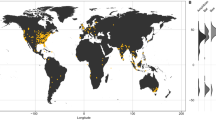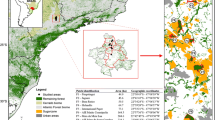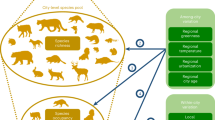Abstract
Ongoing urbanization and land transformation drive profound changes in ecosystems worldwide, with wildlife responding in myriad ways. Particularly, functional homogenization of wildlife communities due to these widespread changes may reduce biodiversity and urban ecosystem resilience. However, there are benefits of urbanization (e.g., increased resources and survival) for some mammal species, likely supported by corresponding traits that facilitate the exploitation of human-dominated landscapes. Using data collected simultaneously from 107 sites throughout the contiguous United States, we explored how urban development, agricultural development, and environmental factors affected mammalian functional diversity (i.e., richness, evenness, and divergence of effect traits) and mean species’ traits at two spatial scales. Although we expected that urbanization would lead to mammal community functional homogenization, we found that urban development was positively associated with functional richness at the camera-site and all three functional metrics at the camera-array scales, whereas environmental variables (i.e., primary productivity, temperature) were not associated with any functional diversity metric. Sampling locations with greater urban development were associated with mammals that had smaller average home ranges, smaller average body sizes, and decreased mean rates of carnivory and scavenging. Identifying the effects of anthropogenic development on ecosystem functioning, as mediated by species' traits, is crucial as urban landscapes continue to expand globally.






Similar content being viewed by others
Data availability
The Snapshot USA 2019 data are available within Cove et al. (2021).
References
Aronson MFJ, Nilon CH, Lepczyk CA et al (2016) Hierarchical filters determine community assembly of urban species pools. Ecology 97:2952–2963. https://doi.org/10.1002/ecy.1535
Bailey RG (1995) Description of the ecoregions of the United States. No. 1391. US Department of Agriculture, Forest Service. https://www.fs.fed.us/rm/ecoregions/downloads/ecoregions-united-states/data-sets/eco-us-shp.zip. Accessed 09 July 2020
Baiser B, Lockwood JL (2011) The relationship between functional and taxonomic homogenization. Glob Ecol Biogeogr 20:134–144. https://doi.org/10.1111/j.1466-8238.2010.00583.x
Barnum TR, Weller DE, Williams M (2017) Urbanization reduces and homogenizes trait diversity in stream macroinvertebrate communities. Ecol Appl 27:2428–2442. https://doi.org/10.1002/eap.1619
Bateman PW, Fleming PA (2012) Big city life: carnivores in urban environments. J Zool 287:1–23. https://doi.org/10.1111/j.1469-7998.2011.00887.x
Botta-Dukát Z, Czúcz B (2016) Testing the ability of functional diversity indices to detect trait convergence and divergence using individual-based simulation. Methods Ecol Evol 7:114–126. https://doi.org/10.1111/2041-210X.12450
Colléony A, Shwartz A (2020) When the winners are the losers: invasive alien bird species outcompete the native winners in the biotic homogenization process. Biol Conserv 241:108314. https://doi.org/10.1016/j.biocon.2019.108314
Contesse P, Hegglin D, Gloor S et al (2004) The diet of urban foxes (Vulpes vulpes) and the availability of anthropogenic food in the city of Zurich, Switzerland. Mamm Biol 69:81–95. https://doi.org/10.1078/1616-5047-00123
Cove MV, Gardner B, Simons TR et al (2018) Free-ranging domestic cats (Felis catus) on public lands: estimating density, activity, and diet in the Florida Keys. Biol Invasions 20:333–344. https://doi.org/10.1007/s10530-017-1534-x
Cove MV, Kays R, Bontrager H et al (2021) SNAPSHOT USA 2019: a coordinated national camera trap survey of the United States. Ecology 102:e03353. https://doi.org/10.1002/ecy.3353
Croissant Y, Zeileis A (2018) truncreg: Truncated Gaussian Regression Models. R package version 0.2–5. https://CRAN.R-project.org/package=truncreg. Accessed 01 Feb 2022
Crooks KR, Burdett CL, Theobald DM et al (2017) Quantification of habitat fragmentation reveals extinction risk in terrestrial mammals. Proc Natl Acad Sci 114:7635–7640
Czech B, Krausman PR, Devers PK (2000) Economic associations among causes of species endangerment in the United States. Bioscience 50:593. https://doi.org/10.1641/0006-3568(2000)050[0593:EAACOS]2.0.CO;2
De Battisti D (2021) The resilience of coastal ecosystems: a functional trait-based perspective. J Ecol 109:3133–3146. https://doi.org/10.1111/1365-2745.13641
de Bello F, Lavorel S, Díaz S et al (2010) Towards an assessment of multiple ecosystem processes and services via functional traits. Biodivers Conserv 19:2873–2893. https://doi.org/10.1007/s10531-010-9850-9
de Bello F, Botta-Dukát Z, Lepš J et al (2021) Towards a more balanced combination of multiple traits when computing functional differences between species. Methods Ecol Evol 12:443–448. https://doi.org/10.1111/2041-210X.13537
Deguines N, Jono C, Baude M et al (2014) Large-scale trade-off between agricultural intensification and crop pollination services. Front Ecol Environ 12:212–217. https://doi.org/10.1890/130054
Donald PF, Green RE, Heath MF (2001) Agricultural intensification and the collapse of Europe’s farmland bird populations. Proc R Soc Lond B Biol Sci 268:25–29. https://doi.org/10.1098/rspb.2000.1325
Flynn DFB, Gogol-Prokurat M, Nogeire T et al (2009) Loss of functional diversity under land use intensification across multiple taxa. Ecol Lett 12:22–33. https://doi.org/10.1111/j.1461-0248.2008.01255.x
Foley JA, DeFries R, Asner GP et al (2005) Global consequences of land use. Science 309:570–574. https://doi.org/10.1126/science.1111772
Forman RTT, Alexander LE (1998) Roads and their major ecological effects. Annu Rev Ecol Syst 29:207–231. https://doi.org/10.1146/annurev.ecolsys.29.1.207
Gámez-Virués S, Perović DJ, Gossner MM et al (2015) Landscape simplification filters species traits and drives biotic homogenization. Nat Commun 6:8568. https://doi.org/10.1038/ncomms9568
Gossner MM, Lewinsohn TM, Kahl T et al (2016) Land-use intensification causes multitrophic homogenization of grassland communities. Nature 540:266–269. https://doi.org/10.1038/nature20575
Groffman PM, Cavender-Bares J, Bettez ND et al (2014) Ecological homogenization of urban USA. Front Ecol Environ 12:74–81. https://doi.org/10.1890/120374
Hansen CP, Parsons AW, Kays R, Millspaugh JJ (2020) Does use of backyard resources explain the abundance of urban wildlife? Front Ecol Evol 8. https://doi.org/10.3389/fevo.2020.570771
Hayes TB, Falso P, Gallipeau S, Stice M (2010) The cause of global amphibian declines: a developmental endocrinologist’s perspective. J Exp Biol 213:921–933. https://doi.org/10.1242/jeb.040865
Heilbron DC (1994) Zero-altered and other regression models for count data with added zeros. Biom J 36:531–547. https://doi.org/10.1002/bimj.4710360505
Hillebrand H, Matthiessen B (2009) Biodiversity in a complex world: consolidation and progress in functional biodiversity research. Ecol Lett 12:1405–1419. https://doi.org/10.1111/j.1461-0248.2009.01388.x
Hughes J, Macdonald DW (2013) A review of the interactions between free-roaming domestic dogs and wildlife. Biol Conserv 157:341–351. https://doi.org/10.1016/j.biocon.2012.07.005
Jones KE, Bielby J, Cardillo M et al (2009) PanTHERIA: a species-level database of life history, ecology, and geography of extant and recently extinct mammals. Ecology 90:2648–2648. https://doi.org/10.1890/08-1494.1
Kays R, Arbogast BS, Baker-Whatton M et al (2020) An empirical evaluation of camera trap study design: how many, how long and when? Methods Ecol Evol 11:700–713. https://doi.org/10.1111/2041-210X.13370
Laliberté E, Legendre P (2010) A distance-based framework for measuring functional diversity from multiple traits. Ecology 91:299–305. https://doi.org/10.1890/08-2244.1
Larson ER, Pool TK (2020) Biological invasions drive biotic homogenization of North American crayfishes. Hydrobiologia 847:3795–3809. https://doi.org/10.1007/s10750-019-04164-2
Lavorel S, Garnier E (2002) Predicting changes in community composition and ecosystem functioning from plant traits: revisiting the Holy Grail. Funct Ecol 16:545–556. https://doi.org/10.1046/j.1365-2435.2002.00664.x
Loss SR, Will T, Marra PP (2013) The impacts of free-ranging domestic cats on wildlife of the United States. Nat Commun 4:1396. https://doi.org/10.1038/ncomms2380
Mack RN, Lonsdale WM (2001) Humans as global plant dispersers: getting more than we bargained for. Bioscience 51:95. https://doi.org/10.1641/0006-3568(2001)051[0095:HAGPDG]2.0.CO;2
Magle SB, Fidino M, Sander HA et al (2021) Wealth and urbanization shape medium and large terrestrial mammal communities. Glob Chang Biol 27:5446–5459. https://doi.org/10.1111/gcb.15800
Magura T, Ferrante M, Lövei GL (2020) Only habitat specialists become smaller with advancing urbanization. Glob Ecol Biogeogr 29:1978–1987. https://doi.org/10.1111/geb.13168
Mann GKH, O’Riain MJ, Parker DM (2015) The road less traveled: assessing variation in mammal detection probabilities with camera traps in a semi-arid biodiversity hotspot. Biodivers Conserv 24:531–545. https://doi.org/10.1007/s10531-014-0834-z
Mason NWH, Mouillot D, Lee WG et al (2005) Functional richness, functional evenness and functional divergence: the primary components of functional diversity. Oikos 111:112–118. https://doi.org/10.1111/j.0030-1299.2005.13886.x
McCune JL, Vellend M (2013) Gains in native species promote biotic homogenization over four decades in a human-dominated landscape. J Ecol 101:1542–1551. https://doi.org/10.1111/1365-2745.12156
McKinney ML (2006) Urbanization as a major cause of biotic homogenization. Biol Conserv 127:247–260. https://doi.org/10.1016/j.biocon.2005.09.005
McKinney ML, Lockwood JL (1999) Biotic homogenization: a few winners replacing many losers in the next mass extinction. Trends Ecol Evol 14:450–453. https://doi.org/10.1016/S0169-5347(99)01679-1
Mertes K, Jetz W (2018) Disentangling scale dependencies in species environmental niches and distributions. Ecography 41:1604–1615. https://doi.org/10.1111/ecog.02871
Mittelbach GG, Schemske DW, Cornell HV et al (2007) Evolution and the latitudinal diversity gradient: speciation, extinction and biogeography. Ecol Lett 10:315–331. https://doi.org/10.1111/j.1461-0248.2007.01020.x
Moll RJ, Cepek JD, Lorch PD et al (2018) Humans and urban development mediate the sympatry of competing carnivores. Urban Ecosyst 21:765–778. https://doi.org/10.1007/s11252-018-0758-6
Morelli F, Benedetti Y, Ibáñez-Álamo JD et al (2016) Evidence of evolutionary homogenization of bird communities in urban environments across Europe. Glob Ecol Biogeogr 25:1284–1293. https://doi.org/10.1111/geb.12486
Morelli F, Benedetti Y, Ibáñez-Álamo JD et al (2020) Insurance for the future? Potential avian community resilience in cities across Europe. Clim Chang 159:195–214. https://doi.org/10.1007/s10584-019-02583-7
Mouchet MA, Villéger S, Mason NWH et al (2010) Functional diversity measures: an overview of their redundancy and their ability to discriminate community assembly rules. Funct Ecol 24:867–876. https://doi.org/10.1111/j.1365-2435.2010.01695.x
Naeem S, Duffy JE, Zavaleta E (2012) The functions of biological diversity in an age of extinction. Science 336:1401–1406. https://doi.org/10.1126/science.1215855
Olden JD (2006) Biotic homogenization: a new research agenda for conservation biogeography. J Biogeogr 33:2027–2039. https://doi.org/10.1111/j.1365-2699.2006.01572.x
Pacifici M, Rondinini C, Rhodes JR et al (2020) Global correlates of range contractions and expansions in terrestrial mammals. Nat Commun 11:2840. https://doi.org/10.1038/s41467-020-16684-w
Padilla BJ, Sutherland C (2021) Defining dual-axis landscape gradients of human influence for studying ecological processes. PLoS One 16:e0252364. https://doi.org/10.1371/journal.pone.0252364
Podani J, Schmera D (2006) On dendrogram-based measures of functional diversity. Oikos 115:179–185. https://doi.org/10.1111/j.2006.0030-1299.15048.x
R Core Team (2021) R: The R project for statistical computing
Rega-Brodsky CC, Aronson MFJ, Piana MR et al (2022) Urban biodiversity: state of the science and future directions. Urban Ecosyst 25:1083–1096. https://doi.org/10.1007/s11252-022-01207-w
Ripple WJ, Estes JA, Beschta RL et al (2014) Status and ecological effects of the world’s largest carnivores. Science 343:1241484. https://doi.org/10.1126/science
Rytwinski T, Fahrig L (2011) Reproductive rate and body size predict road impacts on mammal abundance. Ecol Appl 21:589–600. https://doi.org/10.1890/10-0968.1
Rytwinski T, Fahrig L (2012) Do species life history traits explain population responses to roads? A meta-analysis. Biol Conserv 147:87–98. https://doi.org/10.1016/j.biocon.2011.11.023
Santini L, Gonzalez-Suarez M, Russo D et al (2018) One strategy does not fit all: determinants of urban adaptation in mammals. Ecol Lett 22:365–376. https://doi.org/10.1111/ele.13199
Schwartz MW, Thorne JH, Viers JH (2006) Biotic homogenization of the California flora in urban and urbanizing regions. Biol Conserv 127:282–291. https://doi.org/10.1016/j.biocon.2005.05.017
Sebastián-González E, Barbosa JM, Pérez-García JM et al (2019) Scavenging in the Anthropocene: human impact drives vertebrate scavenger species richness at a global scale. Glob Chang Biol 25:3005–3017. https://doi.org/10.1111/gcb.14708
Sidemo-Holm W, Ekroos J, Reina García S et al (2022) Urbanization causes biotic homogenization of woodland bird communities at multiple spatial scales. Glob Chang Biol 28:6152–6164. https://doi.org/10.1111/gcb.16350
Sotherton NW (1998) Land use changes and the decline of farmland wildlife: an appraisal of the set-aside approach. Biol Conserv 83:259–268. https://doi.org/10.1016/S0006-3207(97)00082-7
Spear D, Chown SL (2008) Taxonomic homogenization in ungulates: patterns and mechanisms at local and global scales. J Biogeogr 35:1962–1975. https://doi.org/10.1111/j.1365-2699.2008.01926.x
Suraci JP, Clinchy M, Zanette LY, Wilmers CC (2019) Fear of humans as apex predators has landscape-scale impacts from mountain lions to mice. Ecol Lett 22:1578–1586. https://doi.org/10.1111/ele.13344
Suraci JP, Gaynor KM, Allen ML et al (2021) Disturbance type and species life history predict mammal responses to humans. Glob Chang Biol 27:3718–3731. https://doi.org/10.1111/gcb.15650
Venter O, Sanderson EW, Magrach A et al (2016) Sixteen years of change in the global terrestrial human footprint and implications for biodiversity conservation. Nat Commun 7:12558. https://doi.org/10.1038/ncomms12558
Villéger S, Mason NWH, Mouillot D (2008) New multidimensional functional diversity indices for a multifaceted framework in functional ecology. Ecology 89:2290–2301. https://doi.org/10.1890/07-1206.1
Weiss KCB, Ray CA (2019) Unifying functional trait approaches to understand the assemblage of ecological communities: synthesizing taxonomic divides. Ecography 42:2012–2020. https://doi.org/10.1111/ecog.04387
Wilman H, Belmaker J, Simpson J et al (2014) EltonTraits 1.0: species-level foraging attributes of the world’s birds and mammals. Ecology 95:2027–2027. https://doi.org/10.1890/13-1917.1
Acknowledgements
We thank the many collaborators and funding sources that allow Snapshot USA to be such a success. We would also like to thank the anonymous reviewers for their constructive feedback on this manuscript.
Author information
Authors and Affiliations
Contributions
All authors participated in the Snapshot USA 2019 sampling efforts. C.R-B. and M.L.A. conceived of the research. S.F., D.J.H., M.C.F-R., J.T., and J.A.C. collected trait and habitat data. K.C.B.W., A.M.G., and F.I. ran the analyses and prepared manuscript figures. M.L.A., C.C.R-B., and D.J.R.L. wrote the initial draft of the manuscript, with all remaining authors elaborating upon and revising the text. All authors reviewed the manuscript and consent with the publication of the study.
Corresponding author
Ethics declarations
Ethics approval
Not applicable
Consent to participate
Not applicable
Consent for publication
Not applicable
Conflicts of interest
Authors declare that they have no competing financial or non-financial interests regarding this work.
Supplementary Information
Below is the link to the electronic supplementary material.
Rights and permissions
Springer Nature or its licensor (e.g. a society or other partner) holds exclusive rights to this article under a publishing agreement with the author(s) or other rightsholder(s); author self-archiving of the accepted manuscript version of this article is solely governed by the terms of such publishing agreement and applicable law.
About this article
Cite this article
Rega-Brodsky, C.C., Weiss, K.C.B., Green, A.M. et al. Mammalian functional diversity and trait responses to anthropogenic and environmental factors across the contiguous USA. Urban Ecosyst 26, 309–322 (2023). https://doi.org/10.1007/s11252-023-01338-8
Accepted:
Published:
Issue Date:
DOI: https://doi.org/10.1007/s11252-023-01338-8




